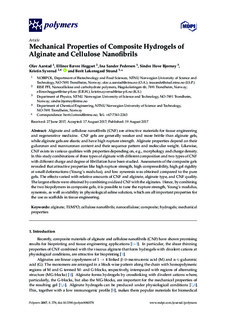| dc.contributor.author | Aarstad, Olav Andreas | |
| dc.contributor.author | Heggset, Ellinor Bævre | |
| dc.contributor.author | Pedersen, Ina S. | |
| dc.contributor.author | Bjørnøy, Sindre Hove | |
| dc.contributor.author | Syverud, Kristin | |
| dc.contributor.author | Strand, Berit Løkensgard | |
| dc.date.accessioned | 2017-10-30T12:01:24Z | |
| dc.date.available | 2017-10-30T12:01:24Z | |
| dc.date.created | 2017-08-22T16:09:05Z | |
| dc.date.issued | 2017 | |
| dc.identifier.issn | 2073-4360 | |
| dc.identifier.uri | http://hdl.handle.net/11250/2462856 | |
| dc.description.abstract | Alginate and cellulose nanofibrils (CNF) are attractive materials for tissue engineering and regenerative medicine. CNF gels are generally weaker and more brittle than alginate gels, while alginate gels are elastic and have high rupture strength. Alginate properties depend on their guluronan and mannuronan content and their sequence pattern and molecular weight. Likewise, CNF exists in various qualities with properties depending on, e.g., morphology and charge density. In this study combinations of three types of alginate with different composition and two types of CNF with different charge and degree of fibrillation have been studied. Assessments of the composite gels revealed that attractive properties like high rupture strength, high compressibility, high gel rigidity at small deformations (Young’s modulus), and low syneresis was obtained compared to the pure gels. The effects varied with relative amounts of CNF and alginate, alginate type, and CNF quality. The largest effects were obtained by combining oxidized CNF with the alginates. Hence, by combining the two biopolymers in composite gels, it is possible to tune the rupture strength, Young’s modulus, syneresis, as well as stability in physiological saline solution, which are all important properties for the use as scaffolds in tissue engineering. | nb_NO |
| dc.language.iso | eng | nb_NO |
| dc.publisher | MDPI | nb_NO |
| dc.rights | Navngivelse 4.0 Internasjonal | * |
| dc.rights.uri | http://creativecommons.org/licenses/by/4.0/deed.no | * |
| dc.title | Mechanical properties of composite hydrogels of alginate and cellulose nanofibrils | nb_NO |
| dc.type | Journal article | nb_NO |
| dc.type | Peer reviewed | nb_NO |
| dc.description.version | publishedVersion | nb_NO |
| dc.source.volume | 9 | nb_NO |
| dc.source.journal | Polymers | nb_NO |
| dc.source.issue | 8 | nb_NO |
| dc.identifier.doi | 10.3390/polym9080378 | |
| dc.identifier.cristin | 1487960 | |
| dc.relation.project | Norges forskningsråd: 228147 | nb_NO |
| dc.relation.project | Norges forskningsråd: 221576 | nb_NO |
| dc.description.localcode | (c) 2017 by the authors; licensee MDPI, Basel, Switzerland. This article is an open access article distributed under the terms and conditions of the Creative Commons Attribution (CC-BY) license (http://creativecommons.org/licenses/by/4.0/). | nb_NO |
| cristin.unitcode | 194,66,15,0 | |
| cristin.unitcode | 194,66,20,0 | |
| cristin.unitcode | 194,66,30,0 | |
| cristin.unitname | Institutt for bioteknologi og matvitenskap | |
| cristin.unitname | Institutt for fysikk | |
| cristin.unitname | Institutt for kjemisk prosessteknologi | |
| cristin.ispublished | true | |
| cristin.fulltext | original | |
| cristin.qualitycode | 1 | |

